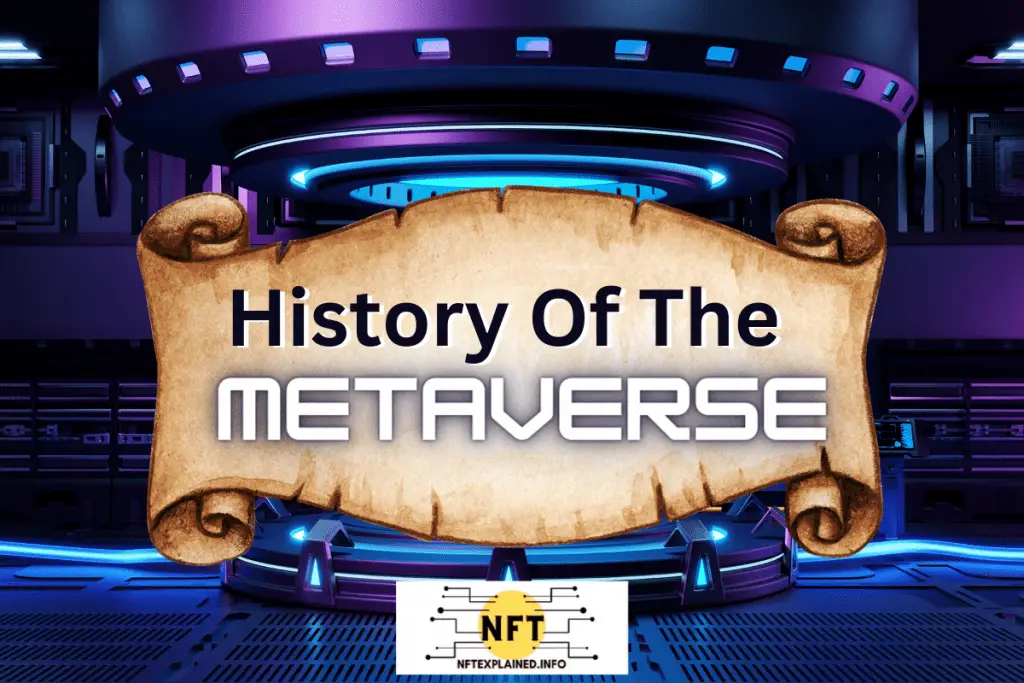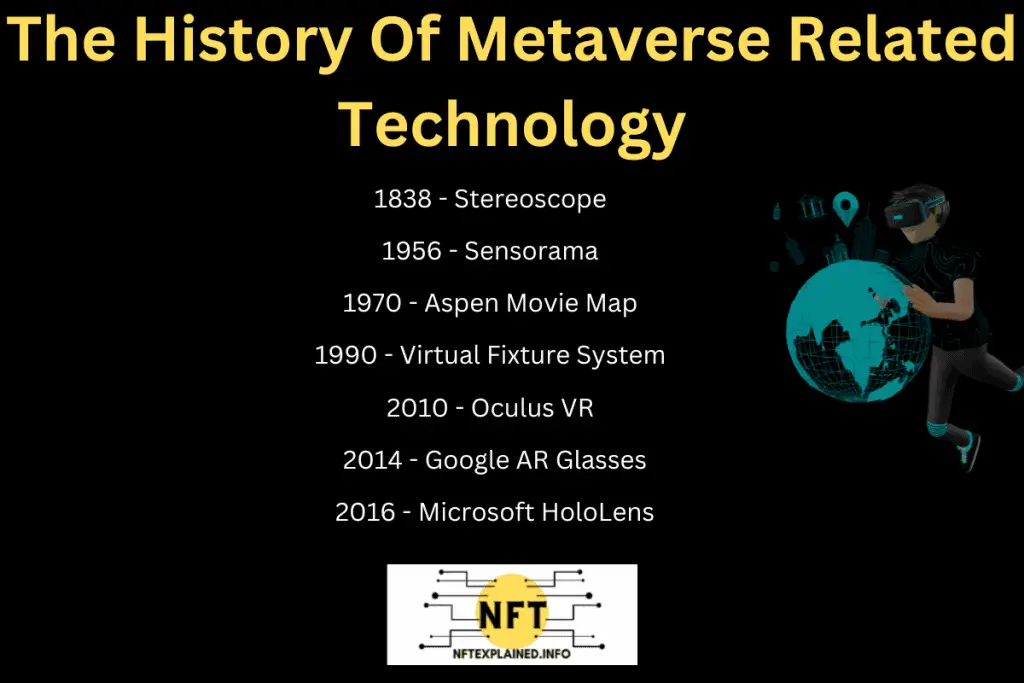
The metaverse is a term that has somewhat lost its value because of how frequently companies – e.g. those that produce typical video games – have claimed to have created a metaverse and due to the loose definition the term currently carries.
Our team has created a full article where we explained exactly what the metaverse is and the core aspects the metaverse is widely agreed to have – interoperability, blockchain technology, a fully immersive environment, the ability to interact with anyone in that 3D space – and more; we will link that here.
Let’s examine a very general overview for the history of the metaverse.
The idea originated in 1935 from Stanley Weinbaum’s book the Pygmalion Spectacles where the main character explored a virtual world via goggles. The term was coined in Neil Stevensons’ 1982 novel, Snow Crash. By 1995, 3D platforms like Active Worlds were released followed by similar platforms, including Second Life in 2003.
In this article, our team will further examine where the term “metaverse” originated, the history of metaverse technology, the history of metaverse games, and some predictions our team has regarding the future for the metaverse.
Active World users could explore 3D virtual worlds and environments in addition to contributing to the creation of the game – an integral aspect of the metaverse.
Following Active Worlds, more platforms that offered similar aspects like Second Life came into play. Second Life had a strong emphasis on creator or user-generated content and allowed for a variety of interactions to occur – the ability to attend virtual events, create avatars, and sell in-game items.
Second Life is a game that has immensely improved from its launch in 2003 and now allows for voice chat and the use of the Oculus Rift (Meta’s VR headset). More on Second Life can be found in our list of top 10 metaverse related projects.
According to estimates, by 2005, there were approximately two million active users across these early metaverse worlds.
There were numerous developments each year from a technological standpoint with regards to VR and graphical capabilities, however, our team is simply providing a brief outline. We will explore further these aspects later in the article.
Innovation with regards to how the metaverse may be accessed occurred in 2010 when Palmer Lucky created the first prototype for the Oculus Rift headset.
A major aspect that brought a lot of attention to this topic was the release of Ready Player One (the book and subsequently the movie) in 2011 and then 2018. Ready Player One explores a dystopian future where the metaverse is accessible via a VR headset.
Fast forward to 2021, Facebook changed their name to Meta, in order to rebrand and prepare themselves for the growth of this new opportunity.
Now that we’ve covered a general history – from the start of the metaverse concept to the early existing metaverses and even the development of technology – lets more closely examine where the term originated.
Where Did The Term “Metaverse” Originate?
The term “metaverse” was coined by Neil Stephonson in his science fiction novel Snow Crash; Snow Crash depicted a futuristic twenty-first century America and follows the hacker Hiro’s efforts to stop Snow Crash from infecting the metaverse. The novel is fast paced, action packed, and involves AI.
Niel Stephenson was an American writer who has published a variety of different novels most notably Snow Crash, which famously popularized the term “metaverse” by blending two words together – “meta” and “universe”.
Without spoiling anything, our team will mention that the destructive and contagious virus – Snow Crash – affects both the metaverse’s ability to function and those who are actually using it.
Now that we have a better understanding of the origin of the word, let’s examine the development of metaverse related technology.
What Is The History Of Metaverse Related Technology?
As the metaverse is still in its infancy stages and being built at this present moment, it’s impossible to say how the metaverse will be accessed in the future; however, we are still able to take a look at the key inventions that have built the metaverse’s foundation.
Many agree that some form of augmented and virtual reality will be used to access the metaverse as it’s widely agreed that the metaverse will be an immersive experience. When did all of this start?
Metaverse related technology dates back to 1838 when Sir Charles Wheatstone invented the stereoscope for 3D images. Jumping to 1956, the Sensorama machine was created which was fully immersive. By 2010, the Oculus rift VR headset was created and by 2014 many major players were working on similar technologies.
A general overview of the events are depicted in the graphic below; we will cover each so you understand how it has led us to where we are today.

Sir Charles Wheatstone was an English scientist and psychologist that created the Stereoscope; the Stereoscope was a 3D image creator that slightly offset two images to produce the illusion of depth. He was credited with the concept of virtual reality and this concept is in use today within modern VR headsets.
In 1956 the first fully immersive machine was created and known as the Sensorama; this device was created by Morton Heiling and was able to simulate a motorcycle ride in New York (Brooklyn) via image display, smell, fans, a motion chair, and a sound system.
The Aspen Movie Map was created by MIT, in the 1970, to produce a computer generated tour by allowing users to use a joystick to navigate through a virtual city (Aspen); this was facilitated by video footage and computer created graphics.
In 1990, Louis Rosenberg created Virtual Fixture Systems, at the U.S. Air Force research library; this creation was essentially AR as it allowed for virtual overlays to occur on top of someone’s real world experience.
By 2010, Palmer Lucky – the founder and CEO of Oculus VR – released the prototype for the VR headset, which provided an immersive experience via aspects like sensors that tracked head movement.
In 2014 Facebook (at the time) acquired Oculus VR for approximately U.S. $2 billion as CEO and founder Mark Zuckerberg perceived the technology to be highly promising.
2014 was also a big year in that large tech conglomerates also began producing metaverse related technology. That same year, Google also released AR glasses which imposed digital information on the user’s eyewear. This was discontinued in 2015 for multiple reasons, most notably privacy concerns.
Two years later in 2016, Microsoft created the HoloLens which was similar in technology to both the Oculus VR headset and the AR glasses previously released. More on the recently released HoloLens 2 can be found in our article about the devices that allow you to immerse yourself in the metaverse, linked here.
2016 also saw the rise of AR technology being used by a variety of consumers with the Pokemon Go craze.
Following 2016, huge investments are being made by enormous tech gains and venture-funded startups; this has continued metaverse development at an astounding rate.
The History Of Metaverse Games
Again, since there are no fully developed metaverses at this time it’s impossible to say the exact timeline for when everything futurist envision will be realized. That being said, our team will look at the crucial inventions that revolutionized gaming and therefore the creation of metaverse related games.
In 1970, Multi-User Dungeon (MUD) came around which was an online text based game. In 1995, Active Worlds was released and allowed users to create their own virtual spaces. By 1997 Ultime Online – a massive multiplayer on-line role playing game – was created and had many features deemed to be a precursor to the modern metaverse.
MUD was a game in which text was used to command avatars around a virtual world and was a popular precursor to immersive environments like Second Life.
Ultime Online allowed users to create their own character, interact with other players, and explore a vast world with monsters. This game was one of the first Massive multiplayer online role-playing games and showed what was possible; it inspired many more MMORPG.
Following Active Worlds, more virtual worlds like Second Life were sprung up; Second Life is a game launched by Linden Labs in 2003. Second Life allows for the creation of an avatar and the ability to interact with others, amongst other abilities.
By 2017, virtual worlds built atop the blockchain like Decentraland sprung to life. Decentraland was a big step towards a fully realized metaverse as users had the ability to monetize their creation via non-fungible tokens.
Now that we’ve covered a brief history of the development of games but more specifically metaverse related games, allow our team to provide some analysis and insight as to what the future of the metaverse may contain.
What Is The Future Of The Metaverse?
Future metaverses will likely contain NFTs; NFTs will be the foundation for the monetizable creator economy. Interoperability – in the sense that digital assets can be used in different metaverses and platforms. Full immersiveness – via emerging technologies like AR or VR among other technological advancements.
The metaverse is a growing industry and it is an exciting time to witness the it’s development. While this field is still in its infancy it’s useful to think critically about the sectors the metaverse will impact and how the development may play out.
Our team is predicting that the metaverse will transform the fashion, remote work, and insurance industry – among many others; more on the sectors the metaverse will impact can be found here.
If you found our content helpful please consider following our team on Instagram, Twitter & TikTok! As well as subscribe to our YouTube!
Additionally, please consider supporting our team’s content creation through doing business with our partners: Buy a Ledger hardware wallet. Trade stocks & crypto on Webull – get 2 free stocks. U.S. users can get a crypto trading discount on Binance!

